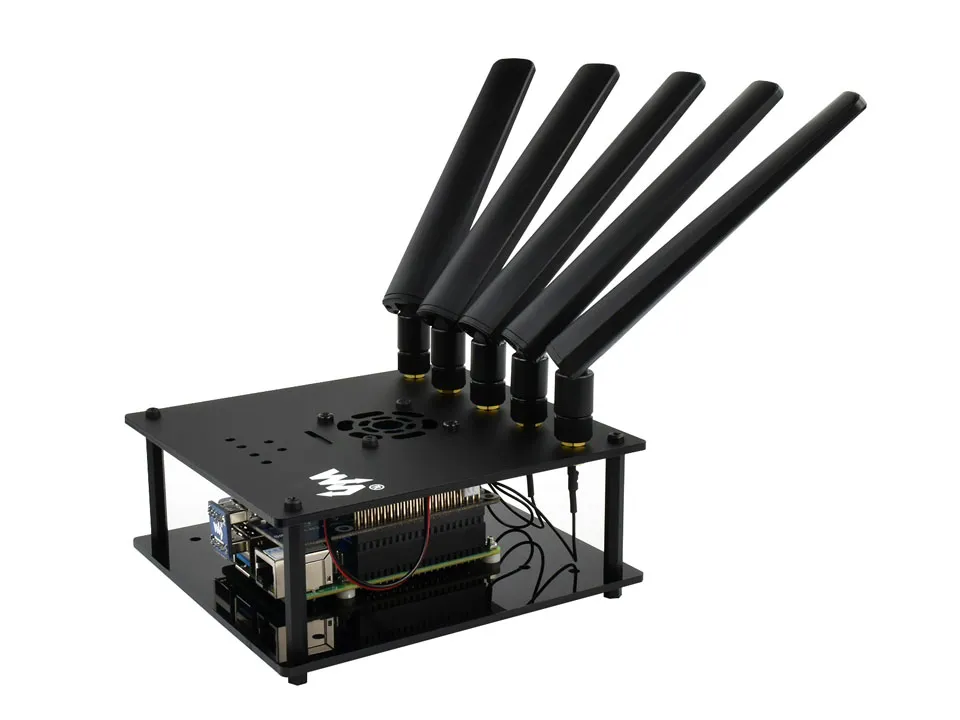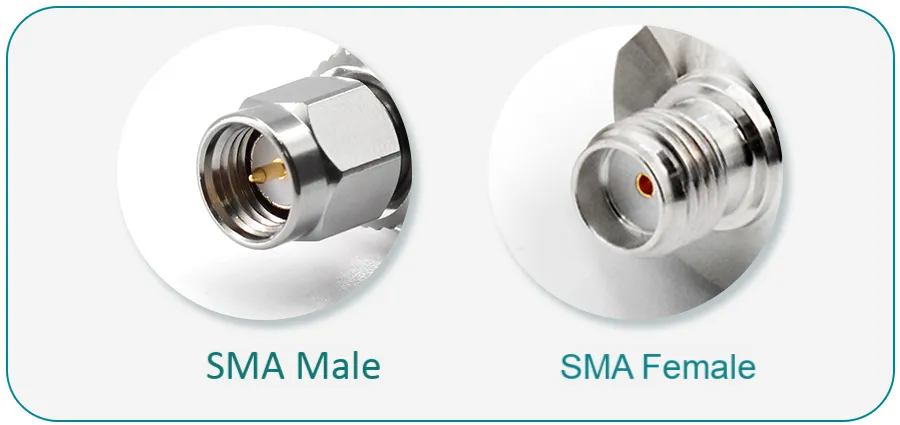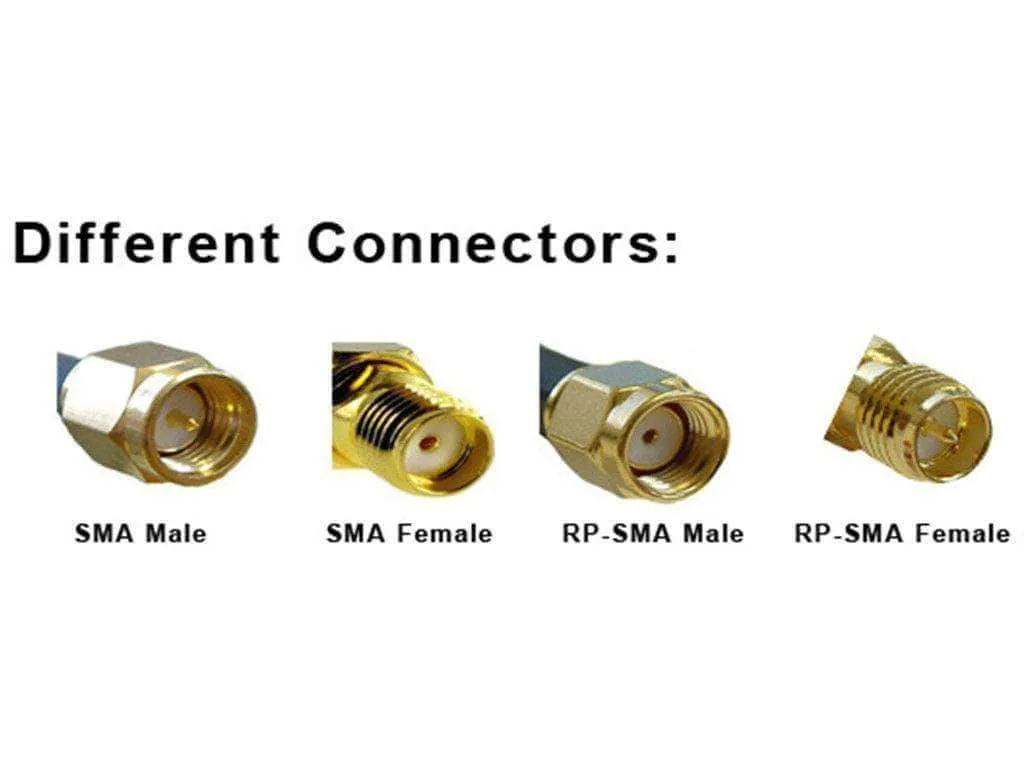Complete Guide to SMA Connectors: Types, Uses, and Selection Tips
Sep 29,2025
Introduction

serving as the opening graphic. It visually demonstrates the widespread use of SMA connectors in various RF equipment, leading into the detailed introduction of their electrical performance, durability (e.g., ≥500 mating cycles), and environmental adaptability (e.g., IP67 rating).
If you’ve spent time around RF equipment, you’ve almost certainly worked with an SMA connector. These small threaded parts show up everywhere—wireless gear, broadcast stations, lab instruments, even home networking setups. Their popularity has little to do with appearance. What really matters is that they keep a stable electrical path while surviving the wear and tear of repeated use.
The TEJTE SMA line demonstrates why. Standard versions handle frequencies from DC up to 6 GHz, making them a safe fit for WiFi routers, GPS receivers, LTE devices, and IoT nodes. Stainless steel precision models raise that bar to 18 GHz or even 26.5 GHz, used when accuracy and low VSWR are critical. Longevity is built in: most are rated for ≥500 mating cycles, with contact resistance kept below 3 mΩ on the inner conductor and 2.5 mΩ on the outer.
Electrical and environmental specs show the same balance. A part like the SMA-J-1.5 supports 335 V working voltage, withstands 1000 V RMS, and maintains insulation resistance ≥5000 MΩ. Temperature ratings stretch wide—–65 °C to +165 °C for brass-gold plated units, and –55 °C to +155 °C for stainless versions. For outdoor networks, IP67 designs stand up to ≤95% humidity at 40 °C and vibration of 150 m/s² between 10–2000 Hz. These numbers explain why SMA connectors remain trusted across so many industries.
How do I choose the right SMA connector?
Selecting the right SMA connector might seem simple, but it’s a decision that can impact your system’s overall performance. The first step is identifying the connector type. SMA connectors come in various configurations, including SMA male, SMA female, right-angle, and bulkhead models. Each type is designed for specific applications, so it’s crucial to choose the right one based on your setup.
For example, if you’re connecting to a female SMA jack on your WiFi router or LTE device, you’ll need a male SMA connector on your cable. On the other hand, if you need to extend your connection or change the direction of the cable, a SMA male-to-female adapter or a right-angle SMA adapter could be what you need. These adapters are commonly used in tight spaces or when you want to minimize cable strain.
Tip: When selecting your SMA connector, always start by considering the device you’re connecting to. Double-check the gender of the port (male or female) and the required polarity to avoid common mistakes like mixing up SMA with RP-SMA connectors.
Next, impedance is a critical factor in choosing the correct connector. Most SMA connectors are designed for 50 ohm systems, which are the standard for most RF communications such as WiFi, LTE, and IoT devices. Using the wrong impedance—such as pairing a 50 ohm connector with a 75-ohm coaxial cable—can result in signal degradation and poor performance.
Pro Tip: If you’re unsure of your impedance requirements, it’s a good idea to check the specification of both the connector and the cable. TEJTE’s SMA connector catalog can help you identify the right parts and their compatibility with your system’s needs.
Material also plays a role in your selection. Gold-plated brass SMA connectors are affordable and work well indoors, but if your system will be exposed to the elements or high vibrations, you should consider stainless steel connectors for better durability and corrosion resistance.
What are the main types of SMA connectors and their uses?

By showing different scenarios (e.g., WiFi, telecom, lab), it visually illustrates the diversity of the SMA connector family and its critical role in various fields (from wireless networks to test instruments), emphasizing the importance of selecting the appropriate type for specific applications.
SMA Male vs SMA Female performance comparison

This physical photo clearly shows the key mechanical differences between SMA male and female connectors: the male has external threads and a center pin, while the female has internal threads and a receptacle socket. The document notes that although RF performance is similar, this mechanical difference determines their installation methods and use cases.
From an RF perspective, both SMA male and SMA female connectors perform similarly, offering VSWR ≤1.10 + 0.002f and insertion loss ≤0.15 dB at 6 GHz. These numbers might seem small, but in high-frequency systems, every decibel matters. However, the key difference lies in the mechanics: SMA male connectors have external threads and a center pin, making them easier to install by hand, while SMA female connectors are usually mounted to devices, panels, or enclosures.
Tip: If you’re working in tight spaces, consider using a right-angle SMA adapter. These adapters help to reroute cables at 90° angles without adding strain to the connection. For a detailed selection, check out TEJTE’s SMA connector catalog.
SMA Plug vs SMA Jack vs SMA Adapter

titled "SMA Male to Female adapter". It shows a physical example of a commonly used SMA adapter. The document explains subsequently that such adapters are used to extend connections or change the direction of the cable, proving useful in tight spaces or when aiming to minimize cable strain, highlighting the versatility of the SMA connector family.
In RF terminology, plug refers to male, and jack refers to female. However, the real versatility comes from the use of SMA adapters, which allow you to connect SMA connectors to other types of connectors. For example, SMA to BNC adapters are common in test environments, where SMA connectors need to interface with BNC-based test instruments like oscilloscopes and signal generators.
Another frequently used adapter is the SMA to N-Type adapter, commonly found in outdoor antenna installations or telecom infrastructure. This adapter allows SMA connectors to connect with N-Type connectors, which are often used for high-power, low-loss applications.
Tip: When choosing an adapter, make sure it matches the connector type and impedance. TEJTE offers a variety of SMA adapters to suit different use cases, from laboratory equipment to outdoor telecom applications.
How do I check the impedance and frequency of SMA connectors?
Impedance Matching: Why it Matters
The majority of SMA connectors are designed for 50 ohm systems, which is the standard for most RF communications, including WiFi, LTE, and 5G applications. Using a 50 ohm connector with 50 ohm coaxial cable ensures low insertion loss, high efficiency, and minimal signal reflection. When selecting connectors for your system, make sure that both the connector and cable match in impedance. For instance, RG316 or RG58 cables are commonly used with 50 ohm connectors, as they provide the correct impedance for most applications.
A common mistake is using a 50 ohm connector with a 75-ohm coaxial cable, which can lead to poor performance and signal degradation. The result? Higher return loss and weak signals, especially at high frequencies.
Pro Tip: Always verify your connector-to-cable impedance before ordering. If you’re unsure, TEJTE’s RF coaxial cable guide can help you identify the right combinations for your setup.
Frequency Range: Understanding Your Needs
Next comes the frequency range. Most standard SMA connectors operate from DC up to 6 GHz, which works perfectly for most wireless applications, including WiFi (2.4 GHz, 5 GHz), GPS, and LTE networks. However, for more specialized applications, such as telecom testing or 5G equipment, you may need connectors that can handle higher frequencies, typically in the 18 GHz to 26.5 GHz range.
For high-precision testing or lab setups, using SMA connectors that support frequencies beyond 6 GHz ensures that your equipment can perform optimally without signal degradation. If you’re involved in advanced RF research or aerospace systems, the frequency capability of your SMA connectors should be considered carefully.
Tip: When working with higher frequency systems, always double-check that your SMA connectors can support the required frequency range. For detailed frequency specs, TEJTE provides a range of high-frequency SMA connectors suitable for specialized telecom and lab environments.
What dimensions and specs should I consider when selecting SMA connectors?
SMA connector sizes and options
SMA connectors come in a variety of sizes and configurations. The most common are straight, right-angle, bulkhead, and panel-mount connectors. The choice depends largely on your device’s layout. For instance, right-angle SMA adapters are great for installations where space is tight, as they allow you to change the direction of the cable without adding strain to the connector. On the other hand, straight SMA connectors are often preferred when the layout allows for cleaner cable routing and no sharp bends.
Pro Tip: When space is limited, consider using right-angle SMA connectors to save space and avoid bending the cable too much, which could lead to signal loss. TEJTE’s SMA connector catalog offers a variety of straight, right-angle, and bulkhead options for different use cases.
SMA connector dimensions
The SMA-J-1.5 is a standard SMA connector, with a typical body length of 15.5 mm and thread size of M6.35 × 0.79 mm. This size is well-suited for Coaxial connectors like RG316, which fit snugly with the connector. For heavier-duty applications, like high-power systems or longer cable runs, SMA-JW-3 connectors are designed to handle RG142 and RG58 cables, with larger dimensions for crimping those thicker cables.
It’s also important to check thread dimensions and body length to ensure proper fitment with your device or system. Many devices use panel-mount SMA connectors for secure mounting to the device, so it’s important to ensure the connector is compatible with the available mounting hole.
Key specifications to consider
Beyond size, here are some essential SMA connector specs to check before making your purchase:
- Working voltage: Most SMA connectors support up to 335 V.
- Withstand voltage: Can handle 1000 V RMS.
- Mechanical durability: A quality SMA connector should be rated for at least ≥500 mating cycles to ensure long-term reliability.
- Insulation resistance: Must be ≥5000 MΩ to prevent shorts and ensure stable performance.
- Operating temperature: –65 °C to +165 °C for brass SMA connectors, and –55 °C to +155 °C for stainless steel versions.
If your application is exposed to the elements or harsh environments, be sure to check for IP67-rated connectors. These connectors are specifically designed for outdoor antenna installations, telecom systems, and other environments where protection from dust and water is crucial.
How do I properly crimp an SMA connector?
Crimping standards for SMA connectors
| Parameter | Recommended Value | Notes |
|---|---|---|
| Crimp tool type | Manual or automatic press | Automatic tools ensure consistent crimping quality |
| Crimp depth | 2.0–2.2 mm | Ensures good contact without damaging the pin |
| Conductor stripping length | 3.0–3.2 mm | Prevents shorts or incomplete connections |
| Dielectric exposure | None | The insulator should remain flush with the connector body |
| Cycle rating after crimp | ≥500 cycles | Ensures connector longevity and durability |
Best practices for crimping SMA connectors
To get the best performance out of your SMA connector, always ensure you’re using the correct crimping tool and stripping lengths. For example, RG316 SMA connectors require precise stripping lengths due to their small diameter, whereas larger cables like RG58 and RG142 need connectors designed for larger ferrules.
Tip: Always verify that the coaxial cable matches the SMA connector. If you’re using RG316, make sure the connector is compatible with its smaller diameter. If you’re working with RG58 or RG142, these cables need a larger SMA connector with a different ferrule size.
After crimping, gently tug on the cable to ensure the connector is securely attached. A well-crimped connector should hold firm without slipping. If the connector comes loose with a small pull, you’ll need to redo the crimping.
Pro Tip: If you’re crimping for high-frequency applications, like WiFi or LTE, make sure to test the connection with a network analyzer to confirm low insertion loss and VSWR. A poorly crimped connector can increase these values, affecting signal integrity.
Why proper crimping matters
Crimping isn’t just about getting the connector onto the cable—it’s about ensuring signal integrity and long-term reliability. A poor crimp leads to increased signal attenuation, reduced power handling, and eventual connector failure.
By following the crimping standards and best practices outlined above, you can ensure that your SMA connectors perform optimally, reducing troubleshooting time and improving the overall efficiency of your RF system.
How do I assess the quality and reliability of SMA connectors before purchase?
Material selection: Brass vs Stainless Steel
Certifications and quality assurance
Always check for certifications before purchasing SMA connectors. Reliable connectors should be RoHS compliant, ensuring they are free from hazardous materials like lead and mercury. Additionally, connectors manufactured under ISO 9001 or similar standards are more likely to maintain consistent performance and meet the industry’s quality benchmarks.
For outdoor and high-performance applications, IP67-rated SMA connectors are essential. These connectors feature O-ring seals that prevent moisture, dust, and dirt from entering the connector, ensuring the system’s stability even in extreme weather conditions. TEJTE offers a variety of IP67-rated SMA connectors that are built to withstand tough environments.
Performance testing
Durability and mating cycles
What are the common mistakes when selecting SMA connectors?
1. Mixing SMA and RP-SMA connectors

within the section "Common mistakes: Mixing SMA and RP-SMA connectors". The chart clearly compares the polarity differences (i.e., reversed pin-and-socket configuration) between standard SMA and RP-SMA male/female connectors. The document emphasizes that this is one of the most common mistakes during selection, as wrong polarity prevents mating and affects signal transmission. This image is a key reference for avoiding this error.
One of the most common mistakes when choosing SMA connectors is confusing SMA with RP-SMA (reverse polarity SMA). While both connectors look similar, RP-SMA has a reversed pin-and-socket configuration, meaning it won’t mate with a standard SMA connector. This mistake is especially common when ordering SMA adapters, as some applications require RP-SMA connectors instead.
Pro Tip: Always verify the polarity of the SMA connectors before purchasing, especially if your application involves RP-SMA connectors. TEJTE’s SMA connector guide can help clarify the differences and guide you in selecting the correct part.
2. Using standard SMA connectors for outdoor applications
Another frequent mistake is using standard SMA connectors in environments exposed to the elements. Standard SMA connectors, even gold-plated versions, are not designed for outdoor use. If used outdoors, they are prone to moisture ingress, corrosion, and signal degradation over time.
For outdoor applications, always choose IP67-rated SMA connectors. These connectors are specifically designed to prevent dust and water from entering the connection, ensuring long-term reliability in telecom installations, IoT systems, or outdoor antennas.
Tip: When using SMA connectors outdoors, always ensure the connectors are IP-rated to prevent issues in harsh conditions. TEJTE’s IP67-rated SMA connectors offer excellent protection against environmental factors.
3. Mismatching SMA connectors with Coaxial connectors
It’s essential to ensure that your SMA connectors are properly matched with the right coaxial cable. Using the wrong cable with your SMA connector can lead to mechanical stress, poor signal quality, and even connector failure. For example, SMA connectors designed for RG316 cables won’t work with RG58 or RG142 cables, as the ferrule size and stripping lengths differ.
Tip: Always confirm that the SMA connector matches the coaxial cable in both diameter and impedance. TEJTE’s coaxial cable guide is a valuable resource for selecting the right
How do SMA connectors perform in antennas and communication devices?
Impedance matching for optimal performance
One of the primary reasons SMA connectors are so popular is their ability to maintain a consistent impedance. 50 ohm connectors are the industry standard for RF applications, including WiFi (2.4 GHz, 5 GHz), LTE, 5G, GPS, and IoT systems. These connectors ensure low insertion loss and minimal signal reflection, crucial for maintaining high-quality, uninterrupted signal transmission.
For video and broadcasting applications, 75-ohm SMA connectors are also used, as they help minimize reflections, providing better signal integrity over longer distances. However, it’s essential to match the connector and cable impedance to avoid poor performance and signal degradation..
Frequency range: Selecting the right connector for your system
The frequency range of SMA connectors is another key factor when selecting the right part for your system. Standard SMA connectors typically cover frequencies from DC to 6 GHz, making them suitable for a wide range of WiFi, LTE, and GPS applications. For higher-frequency needs, stainless steel SMA connectors are available, with capabilities extending to 18 GHz and even 26.5 GHz, providing exceptional performance in more advanced systems such as test equipment or telecom testing gear.
Pro Tip: If you’re involved in high-frequency applications, such as 5G testing or advanced RF research, make sure to select SMA connectors rated for 18 GHz or higher to ensure the best performance. TEJTE’s high-frequency SMA connectors offer a range of options suitable for specialized telecom and laboratory environments.
SMA connectors in antenna applications
SMA connectors play a vital role in antenna systems, from indoor WiFi setups to outdoor 5G antennas. For indoor antenna installations, SMA connectors are commonly paired with RG316 or RG174 Coaxial connectors, providing a flexible and reliable solution for short-run connections. These connectors offer a stable connection while being compact enough to fit into smaller devices.
For outdoor antenna systems, especially in telecom towers, smart city IoT networks, or GPS systems, IP67-rated SMA connectors are essential. These weatherproof connectors ensure the system remains reliable in harsh environments, protecting against water ingress and dust buildup. TEJTE’s IP67-rated SMA connectors are specifically designed for such high-demand outdoor applications.
How do I order SMA connectors from TEJTE?
1. Choose the connector type
Start by selecting the right connector type based on your application. TEJTE offers a variety of SMA connectors in different configurations, including male, female, straight, right-angle, and IP67-rated waterproof models. The type you choose depends on your system layout and the specific requirements of your device.
For outdoor antennas or telecom systems, always go for IP67-rated SMA connectors to ensure protection against dust and water. These connectors are designed for environments with high humidity and vibration—perfect for 5G networks or smart city infrastructure.
Pro Tip: When ordering for outdoor applications, always verify the IP rating to ensure the connector will withstand environmental factors such as moisture, dirt, and temperature extremes. TEJTE’s IP67-rated SMA connectors offer excellent protection for demanding applications.
2. Check cable compatibility
Once you’ve chosen your SMA connector type, the next step is to ensure cable compatibility. TEJTE provides SMA connectors compatible with RG316, RG58, RG142, and other Coaxial connectors. Selecting the right combination is crucial for ensuring low insertion loss and long-term reliability.
For flexible applications, RG316 works well with SMA connectors, while RG58 and RG142 are better suited for longer cable runs or higher power applications.
Tip: Double-check the connector-to-cable match to avoid mechanical stress or poor signal quality. TEJTE’s RF coaxial cable guide provides detailed compatibility information to help you make the right choice.
3. Custom SMA connectors
4. Review product specifications
Frequently Asked Questions
How do I choose between SMA male and SMA female connectors?
Choosing between SMA male and SMA female connectors depends on the device you’re connecting to. Most WiFi routers, LTE modules, and other communication devices come with female SMA jacks, so you’ll need a male SMA connector on your cable. Conversely, many test instruments like signal generators have male SMA ports, which means you’ll need a female SMA connector on the mating cable.
Pro Tip: If you’re unsure about your device’s connector type, always check the user manual or product specifications to ensure you’re ordering the right gender. TEJTE’s SMA connector guide provides helpful tips on identifying the correct connector type.
What is the difference between SMA male to female adapters and SMA right-angle adapters?
An SMA male-to-female adapter simply extends the existing connection between devices, while an SMA right-angle adapter allows you to change the direction of the cable, making it ideal for tight spaces or installations where you want to minimize cable strain. Right-angle adapters are especially useful when you need to navigate around obstacles or avoid excessive cable bending.
Tip: When working with limited space or cramped enclosures, opt for right-angle SMA adapters to help reroute the cables without compromising performance. TEJTE’s SMA adapters come in various configurations to suit different applications.
How do I correctly crimp an SMA connector?
To ensure a proper connection, it’s crucial to follow the recommended crimping standards. For example, SMA connectors designed for RG316 coax require a stripping length of 3.0–3.2 mm and a crimp depth of 2.0–2.2 mm. Using the right crimping tool and following the guidelines ensures a secure connection with minimal insertion loss.
Pro Tip: Always verify the coaxial cable matches the SMA connector you’re using. For RG58 or RG142, ensure the connector is compatible with the larger cable diameters. TEJTE’s crimping standards guide is a great reference for proper crimping techniques.
What materials should I choose when buying SMA connectors for outdoor use?
For outdoor applications, especially in environments prone to moisture, dust, or high vibration, stainless steel SMA connectors are recommended. These connectors offer superior corrosion resistance and are much more durable than brass versions. Pairing these with IP67-rated sealing ensures the connector will perform reliably, even in harsh weather conditions.
Tip: If your setup will be exposed to rain, dust, or humidity, make sure you choose IP67-rated SMA connectors for maximum protection. TEJTE’s outdoor SMA connectors are built for tough environments and provide excellent durability.
What are the common mistakes when selecting SMA connectors for RF applications?
One of the most common mistakes is mixing up SMA and RP-SMA connectors. The difference is in the pin and socket orientation—RP-SMA reverses the usual pin/socket configuration. Using these inappropriately can lead to incompatible connections and unreliable signal transmission.
Another mistake is using non-waterproof SMA connectors in outdoor applications. Even gold-plated SMA connectors can fail when exposed to moisture and dust. For outdoor or high-vibration environments, always choose IP67-rated SMA connectors to ensure your system remains operational over time.
Pro Tip: If you’re unsure whether your setup requires RP-SMA, always check the device’s connector type. TEJTE’s SMA connector FAQ is a great resource to clarify any confusion.
How do I verify the quality of SMA connectors before purchasing?
What is the best SMA connector for antenna connections?
For indoor antennas, standard brass SMA connectors work fine for most applications. However, for outdoor antennas exposed to the elements, you should use stainless steel SMA connectors with IP67 sealing. This ensures that your system remains corrosion-free and reliable even in harsh weather conditions.
Tip: Always pair the right SMA connector with the correct cable for optimal antenna performance. TEJTE’s RF antenna guide offers detailed advice on matching SMA connectors with different antenna types.
Bonfon Office Building, Longgang District, Shenzhen City, Guangdong Province, China

A China-based OEM/ODM RF communications supplier
Table of Contents
Owning your OEM/ODM/Private Label for Electronic Devices andComponents is now easier than ever.
